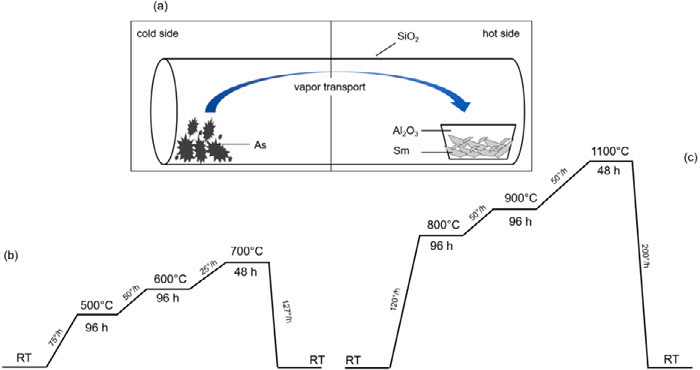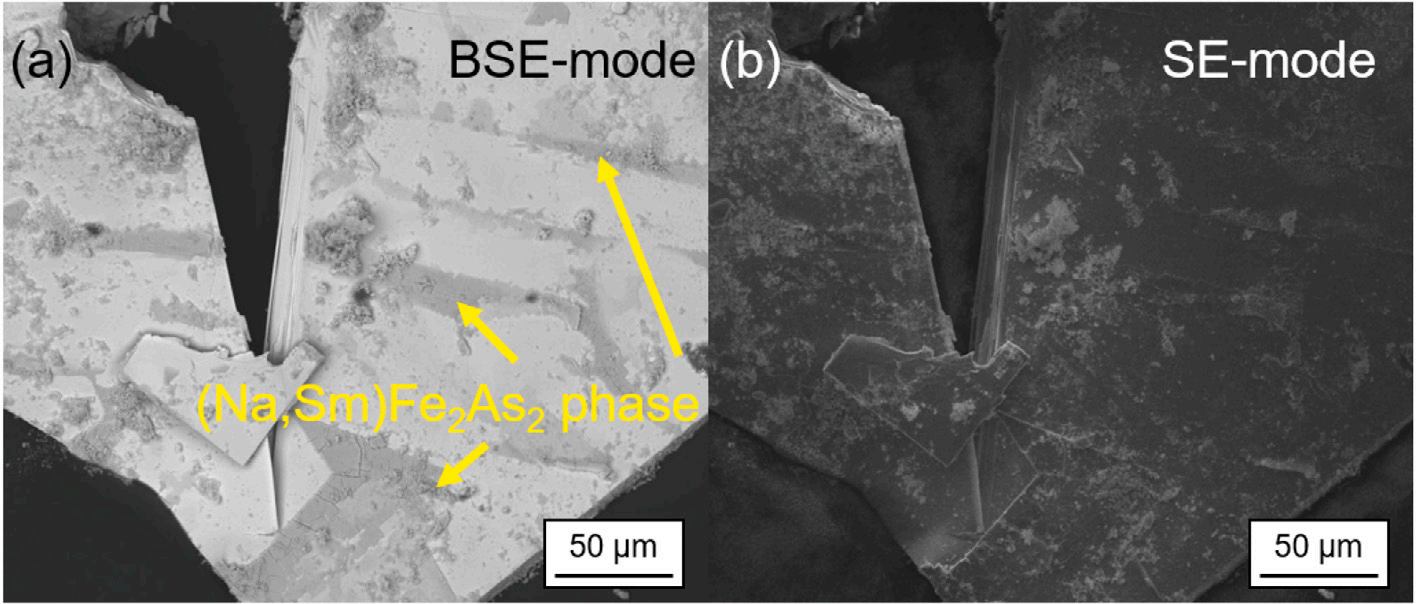A B S T R A C T
In this work we report the crystal growth of SmOFe1−𝑥Co𝑥As single crystals with Co content 0 ≤ 𝑥 ≤ 0.25 via the solid-state single crystal growth method at ambient pressure. The centrepiece of this method is to trigger the abnormal grain growth process, where only a small amount of grains grows significantly larger than the majority of grains. In its extreme case, this diffusion-controlled process in the solid state may foster large and three-dimensional crystals that grow out of a polycrystalline matrix. Since most parameters known to trigger solid-state single crystal growth are known only empirically, we discuss in detail which are the optimal parameters for the growth of SmOFe1−𝑥Co𝑥As single crystals and rationalize the mechanisms that may be relevant to activate the diffusion-driven solid-state single crystal growth in the system under study. The plate-like crystals show distinct facets, which is a common feature of crystals grown by this method, with lateral dimensions of up to 4.8 mm and a thickness of up to 0.06 mm. The single crystals of this series as well as the corresponding polycrystals were characterized and compared regarding their crystal structure, chemical composition, morphology as well as magnetic and superconducting properties. Interestingly, our characterization data suggest a solubility gap for high Co contents. This finding is supported by comparing with previous reports, albeit existence of a solubility gap is not discussed therein. As expected across the series, charge doping suppresses the structural and magnetic transitions until for 5% Co content superconductivity is established. In particular, the splitting and clear differentiation of the structural and subsequent magnetic transition is rarely seen for 𝑅𝐸OFeAs compounds, but well resolved for the Fe-rich SmOFe1−𝑥Co𝑥As single crystals and even for the 𝑥 = 0.0125 crystal, but smeared out for the corresponding polycrystalline samples. Hence, the SmOFe1−𝑥Co𝑥As single crystal presented in this work are of exceptional high quality.
1. Introduction
The Fe-based superconductors are frequently categorized in four main families and accordingly labelled referring to their stoichiometry, such as the series 1111 (representing 𝑅𝐸OFeAs and 𝐴𝐸FFeAs with 𝑅𝐸 a rare earth and 𝐴𝐸 an alkaline earth metal), 122 (for 𝐴𝐸Fe2As2 with 𝐴𝐸 and 𝐴Fe2As2 with 𝐴 alkaline metal) , 111 (as for 𝐴FeAs) and 11 (FeSe1−𝑥Te𝑥 ). The prototypical 1111, namely LaOFeAs, undergoes a structural phase transition at 𝑇𝑠 = 160 K from high temperature tetragonal to orthorhombic followed by formation of a spin density wave and antiferromagnetically order at 𝑇𝑁 = 140 K . Upon charge doping, both transitions broaden and shift to lower temperature while, up from a certain substitution level, superconductivity evolves. Charge doping in 1111 compounds is established, e.g., (i) upon sufficient replacement of oxygen (O) by fluorine (F) , (ii) by substituting a certain amount of iron (Fe) by cobalt (Co) , or (iii) by introducing oxygen deficiencies . External pressure may also affect both the magnetically ordered and the superconducting phase . An analogous sequence of phase transitions was also observed for 1111 compounds with different 𝑅𝐸 elements, 𝑅𝐸OFeAs, where 𝑅𝐸 = Gd, Nd, Sm are prominent examples, respectively. However, while polycrystals of LaOFeAs show a discernible splitting of the structural and magnetic transition, only one broad anomaly at 150 K is observed for SmOFeAs polycrystals, representing a concomitant and/or unresolved/overlapping structural and magnetic transition. As for the LaOFeAs prototype, superconductivity in SmOFeAs is achieved by the above mentioned doping variants but with a generally increased maximum critical temperature 𝑇𝑐 independent of the type of charge doping due to replacement of the nonmagnetic La3+ ion (𝑟 = 103 pm) by the homovalent magnetic and smaller Sm3+ ion (𝑟 = 95.8 pm). Specifically, SmO0.9F0.1FeAs shows superconductivity below 55 K, while the La sister compound LaO0.89F0.11FeAs has a critical temperature of 𝑇𝑐 = 26 K. Co doping, as disturbing the FeAs layer, leads in general to lower transition temperatures compared to those achieved by doping in the 𝑅𝐸-O charge reservoir layer, e.g., a 𝑇𝑐 = 13–14 K upon optimal doping was obtained in LaOFe1−𝑥Co𝑥As, while the maximum critical temperature is 𝑇𝑐 = 17.2 K in the corresponding SmOFe1−𝑥Co𝑥As series. The critical temperature 𝑇𝑐 of optimal Co doped SmOFe0.9Co0.1As could be further increased to 23 K by concomitant Co and F doping yielding, e.g., SmO0.85F0.15Fe0.9Co0.1As. Measurements of the Hall coefficient revealed that the higher 𝑇𝑐 is caused by the higher charge carrier density of SmO0.85F0.15Fe0.9Co0.1As compared to SmOFe0.9Co0.1As. More recently, Zuo et al. have investigated the influence of Co doping on the lattice dynamics of SmO(Fe,Co)As using Mößbauer spectroscopy.
2. Experimental details
The growth behaviour, crystal morphology and chemical composition were accessed using a scanning electron microscope (SEM) (Zeiss EVO MA 15) equipped with an energy dispersive X-ray analyser (EDX) and AzTec software. Poly- and single crystals were investigated in secondary electron (SE) mode and in particular in back scattered electrons (BSE) mode, which gives a topological contrast and an elemental contrast, respectively. On each specimen, and the averaged elemental composition was determined by averaging over at least 10 EDX point measurements.
The crystal structure was investigated using powder and single crystal X-ray diffraction methods. The diffractograms of ground powders were recorded with a STOE STADI in transmission geometry using Co-K𝛼1 radiation, a Ge monochromator and a DECTRIS Mythen 1K detector. From the obtained diffraction data, further structural information such as lattice parameters were obtained using the Rietveld method as implemented in the Jana2006 software. Single crystals were examined on a Bruker X8 Apex2 CCD4K with Mo-K𝛼1 radiation.
3. Synthesis and crystal growth
The hygroscopic Fe2O3 was heated in a quartz tube furnace under oxygen flow (50 ml∕h) for 48 h to 600 ℃ to eliminate any adsorbed H2O. SmAs was prepared in an evacuated quartz ampoule via transport reaction in a two-zone-furnace as illustrated in Fig. 1. For this, As chunks and Sm (Mateck, 99.9%) metal chips in an Al2O3 boat were placed at opposite ends of an evacuated ampoule to avoid direct contact during reaction. SmAs is formed by a vapour transport reaction (see Fig. 1(a,b,c)). The As lumps are placed at the cold side and the overall temperature is sufficient to evaporate a small but sufficient amount of As. Sm is at the hot side and this way reacts with As in a controlled and slow process yielding SmAs avoiding an uncontrolled exothermic reaction.

Fig. 1. (a) Illustration of the set-up for the vapour transport reaction of SmAs, (b) the temperature profile on the As (cold) side and (c) the temperature profile on the Sm (hot) side.
4. Results and discussion
As the parameters to establish large grains growing out of a polycrystalline matrix via a diffusion-driven solid state process are mostly of empirical character, we attempt to rationalize the optimization of parameters for the SmOFe1−𝑥Co𝑥As system and to explore the mechanism that favours abnormal grain growth of some SmOFe1−xCo𝑥As. Table 2 summarizes the growth parameters that were showing highest impact for SmOFeAs. A typical crystal yield is shown in Fig. 2. As starting point, we used the optimal conditions previously reported for LaOFeAs and further optimized them by varying experimental parameters for the SmOFe1−𝑥Co𝑥As series as discussed in the following.

Fig. 2. Photographs of SmOFeAs single crystals obtained with annealing at (a) 975 ◦C for 200 h, (b) 1035 ◦C for 48 h and slow cooling to 975 ◦C, (c) 1035 ◦C for 200 h and (d) 1035 ◦C for 600 h over a 1 mm grid.
Cooling rate
In our experiments, we have no hints that the cooling rate has an impact on the size of the crystals, as would be expected for a solubility driven growth mechanism. As a result of slowly cooling, parasitic (Na,Sm)Fe2As2 is found on the surface of the crystals (Fig. 3). The formation of the (Na,Sm)Fe2As2 surface layer is suppressed upon fast cooling. Nevertheless, the thin layer of the parasitic phase can be easily removed with sand paper.

Fig. 3. (a) BSE and (b) SE picture of a SmOFeAs single crystal grown by slow cooling procedure (see Table 2(b) for experimental details)
5. Summary
The SSCG method was used to grow SmOFe1−𝑥Co𝑥As single crystals from their polycrystalline matrix on a millimeter scale. Most parameters known to trigger solid-state single crystal growth are known only empirically, we, therefore, discuss in detail which are the optimal parameters for the growth of SmOFe1−𝑥Co𝑥As single crystals and rationalize the mechanisms considered relevant to trigger the diffusion-driven solid-state single crystal growth in the system under study. Among those parameters are dwell temperature, dwell time and cooling rate, role of a liquid aid, and role of chemical bonding in SmOFe1−𝑥Co𝑥As. Condensing the investigations into an optimized growth protocol we were able to foster growth of faceted SmOFe1−𝑥Co𝑥As single crystals with lateral dimensions of up to 4.8 mm and a thickness of up to 0.06 mm. The lattice parameters of samples with Fe-rich composition closely follow Vegards law and are found very homogeneous by xray microscopic and spectroscopic techniques. Co-rich samples show subtle but unambiguous indications of an inhomogeneous distribution of Co up from 0.15 ≤ 𝑥 ≤ 0.25. These observations do not depend on the type of samples, viz. their poly- or single crystalline nature. Taking the hints from several different experimental methods, we infer that there is a solubility gap up from 𝑥 ≈ 0.15. This gap does not extend up to SmOCoAs as this compound has been reported. Analogous hints on a solubility gap are found in literature. We compare the physical properties of a series of SmOFe1−𝑥Co𝑥As single crystals with their polycrystalline counterparts. In particular, the splitting and clear differentiation of both the structural and magnetic transitions is well resolved for the Fe-rich underdoped SmOFe1−𝑥Co𝑥As single crystals, but broad with the structural and magnetic transition overlapping for the corresponding polycrystalline samples. Hence, the SmOFe1−𝑥Co𝑥As single crystal presented in this work are of exceptional high quality.